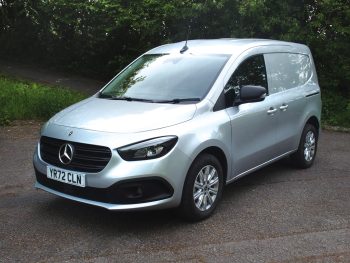All-new compact high-cube van delivers tangible improvements, says John Kendall.

The latest Mercedes-Benz Citan is, as you might expect, the result of the ongoing collaboration between Mercedes-Benz and the Renault Alliance. The result is the Citan, Renault Kangoo and Nissan Townstar, all based on the same bodyshell and power options, with each manufacturer deciding which engines they will use.
For Mercedes-Benz, the power choices are either the 95hp 1,461cc four-cylinder turbodiesel, as tested here or the electrically-powered eCitan, scheduled to arrive later this year. The diesel engine will be familiar to previous model Citan owners and drivers. It is based on Renault’s long-running 1.5-litre diesel engine, which has developed a reputation for reliability and durability over the years.
Panel van variants are available in two lengths, as with the previous model, while a five-seat crew van will also form part of the range. In design terms the more rounded appearance of the original model has made way for a sleeker look. Inside, there’s a new dashboard, which echoes the features and design elements of the larger Vito and Sprinter models.
There are two trim options: Progressive and Premium. Progressive trim includes a multifunction steering wheel, adjustable for rake and reach, smartphone integration and an armrest with storage compartment beneath.
Our test van was in Premium trim, which brings LED headlamps and front foglamps, 16-inch alloy wheels, body-coloured bumpers and metallic paint. Inside, the interior trim features high gloss black and chrome detailing. There is a full-height bulkhead and plastic floor covering in the load compartment. In terms of driver convenience, Premium trim also includes heat-insulating glass, useful at the time of writing, a reversing package including camera, cruise control with speed limiter, high-beam assist (automatic headlamp dipping) and an alarm. The MBUX multi-media package is also part of the Premium specification, featuring a seven-inch touchscreen. In addition, there is USB C and Bluetooth connectivity, a Wi-Fi hotspot and Apple CarPlay and Android Auto to connect your phone. It’s a useful specification, without being overdone.
The new bodyshell succeeds in offering tauter handling and reduced noise on the road, compared with the previous model. Our test mileage included local and long-distance running and the Citan was a comfortable vehicle for both. Like its predecessor it is easy to drive with light controls and slick gearshift. Mercedes offers an automatic option too if your routes involve stop/start city driving, or you just want the convenience of an automatic.
Fuel consumption got close to the official combined figure during our test, observing the speed limits for a light CV over 2,000kg gross vehicle weight. We returned an indicated 52.3mpg on test, a good result and comparable with its rivals. Performance was good, running lightly loaded and there should be adequate performance in all loaded conditions.
Our shorter L1 test van includes a side sliding load door and asymmetric rear doors which will open to 180°, enabling loading with a forklift. The load space has been designed to ensure there is minimal intrusion from the wheel-arches, providing a good regular-shaped load area and relatively low loading height.
IN BRIEF
WHAT IS IT? Compact high-cube van
HOW MUCH? From £23,285 (ex-VAT)
GROSS PAYLOAD? 666kg
ECONOMY? 54.3mpg (WLTP)
DRIVE? 1.5-litre diesel engine, front-wheel drive, 95hp/260Nm of torque
VERDICT
The new Mercedes-Benz Citan delivers notable improvements compared with its predecessor and offers fleet operators a comfortable van that should be easy on drivers and fleet budgets.

